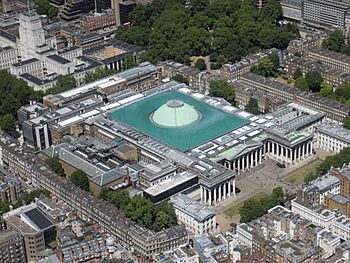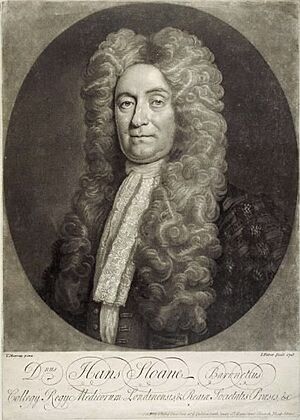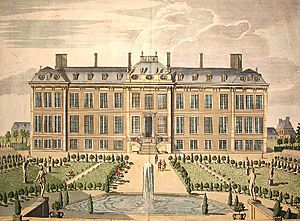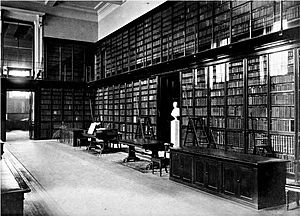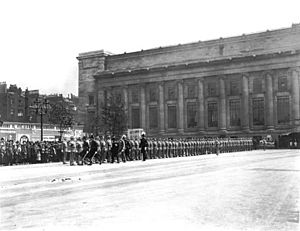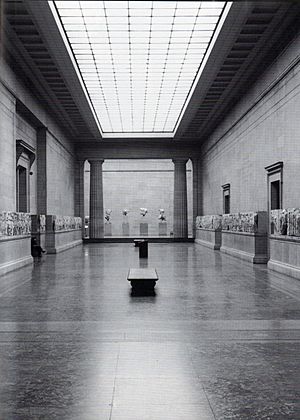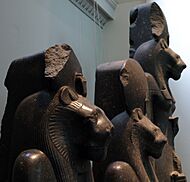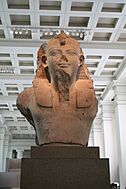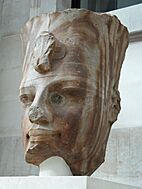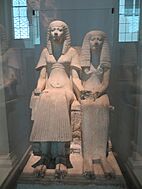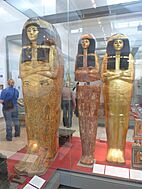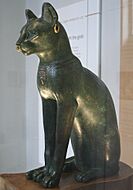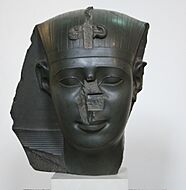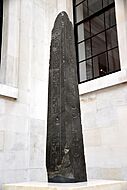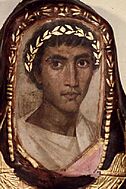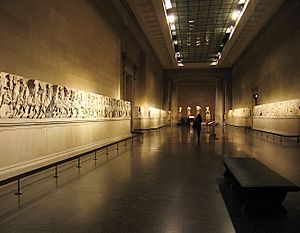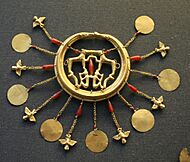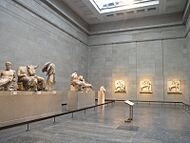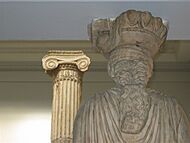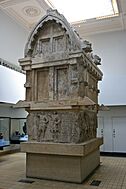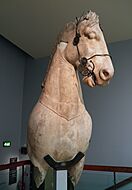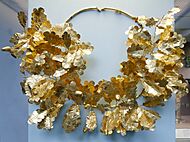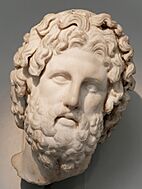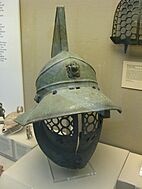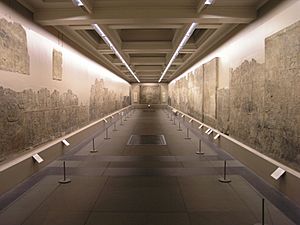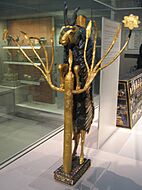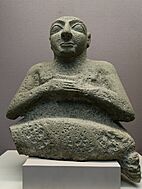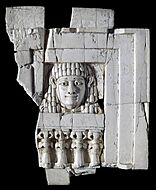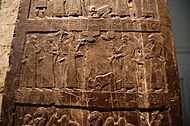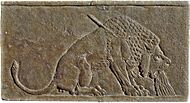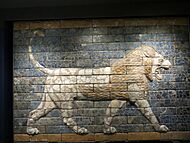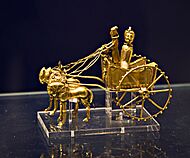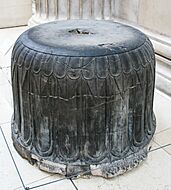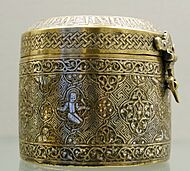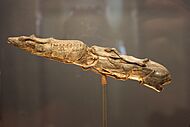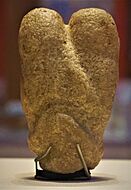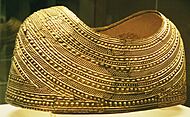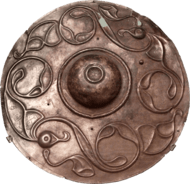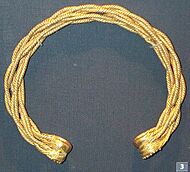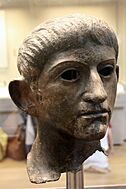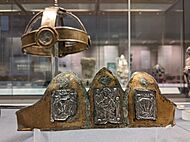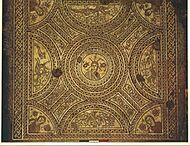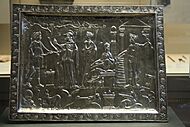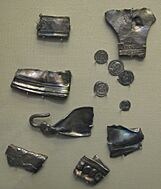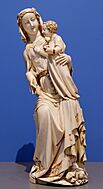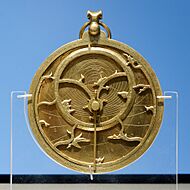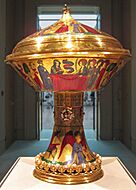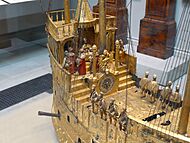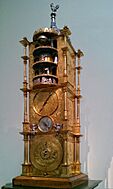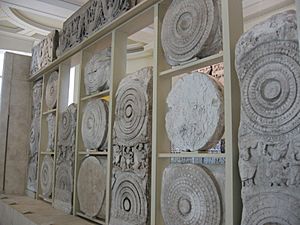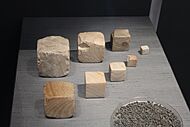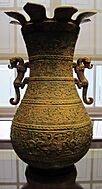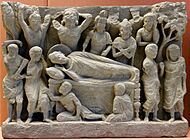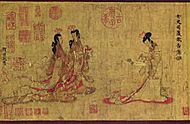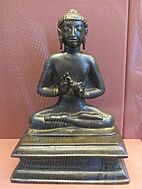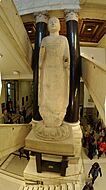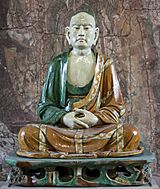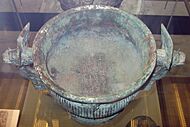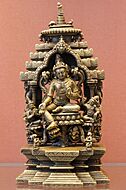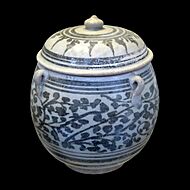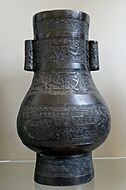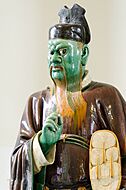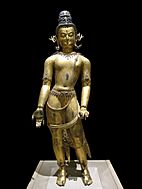British Museum facts for kids
The British Museum is a famous museum in London, England. It's all about human history, art, and culture. Imagine a giant collection of about eight million items from all over the world! This museum tells the story of human culture from the very beginning until today. It first opened in 1753 and was the world's first public national museum. In 2023, over 5.8 million people visited, making it one of the most popular places in the United Kingdom.
The museum started with the amazing collections of a doctor and scientist named Sir Hans Sloane. It opened its doors in 1759 in a building called Montagu House. Over the next 250 years, the museum grew a lot, often adding items from different parts of the world. Some of its most famous pieces, like the Greek Elgin Marbles and the Egyptian Rosetta Stone, are part of ongoing discussions about where they should be kept.
In 1973, the museum's library section became a separate place called the British Library. However, the library stayed in the same building until 1997. The British Museum is a public organization supported by the government. Like other national museums in the UK, it's free to enter, except for special temporary exhibitions.
Contents
- A Journey Through Time
- Museum Departments
- Museum Building and Galleries
- Digital and Online
- Exhibitions
- See also
A Journey Through Time
How the Museum Began
The British Museum was created to be a "universal museum," meaning it would collect all kinds of things. It all started with the will of Sir Hans Sloane (1660–1753), a doctor and scientist from London. He had a huge collection of interesting objects. He didn't want his collection to be split up after he died. So, he left it to King George II for the nation. Parliament paid his family £20,000 for it, which was much less than it was worth.
Sir Hans Sloane's collection had about 71,000 items. These included 40,000 books, 7,000 handwritten papers, and many natural history items. He also had ancient objects from Sudan, Egypt, Greece, Rome, and the Americas.
The Museum Opens (1753)
On June 7, 1753, King George II officially approved the law that created the British Museum. This law also added two other important libraries to Sloane's collection. These were the Cottonian Library and the Harleian Library. Later, in 1757, the "Old Royal Library" joined them. These first collections included many famous books now in the British Library, like the Lindisfarne Gospels and the only surviving copy of Beowulf.
The British Museum was a new kind of museum. It belonged to the nation, not a church or a king. It was also free for everyone to visit and aimed to collect everything. Sloane's collection showed his interest in science. The added libraries brought in many literary and ancient items. This made the British Museum both a national museum and a library.
Early Years and Growth (1753–1825)
The museum's leaders chose Montagu House, a large 17th-century home, as its location. They bought it for £20,000. The first exhibition rooms and a reading room for scholars opened on January 15, 1759. At first, most of the collection was books and natural history items.
In 1772, the museum bought its first important ancient art: a collection of Greek vases from Sir William Hamilton. Later, objects from Captain James Cook's voyages around the world were displayed. These items from the South Seas showed visitors lands they had never seen before.
The museum quickly became too crowded. In the early 1800s, it started collecting many sculptures. After a battle in Egypt in 1801, the British Museum received more Egyptian sculptures. In 1802, King George III gave the museum the Rosetta Stone. This stone was super important because it helped people understand ancient Egyptian writing called hieroglyphs.
Many Greek sculptures also arrived, including the famous Elgin Marbles from the Parthenon in Athens. In 1823, King George III's personal library, with 65,000 books, was given to the museum. This led to plans for a new, much larger building. The old Montagu House was torn down, and construction began on the new neoclassical building, which is mostly what you see today.
A Huge Construction Site (1825–1850)
As the new building slowly went up, the museum was a busy construction site. The King's Library on the ground floor was finished in 1827. It was considered one of the most beautiful rooms in London.
In 1840, the museum started its first overseas digs. These included expeditions to Xanthos in Asia Minor, where parts of ancient tombs were found. Later, the Mausoleum at Halicarnassus, one of the Seven Wonders of the Ancient World, was discovered. The museum also supported digs in Assyria, which led to the discovery of a huge library of cuneiform tablets. These tablets helped people learn a lot about ancient Assyrian life.
Expanding Collections (1850–1900)
By 1852, the main part of the new building was finished. But the collections kept growing! A new circular Reading Room was built in 1857. It had space for a million books. Because there was still not enough room, the natural history collections were moved to a new building. This new building later became the Natural History Museum.
During this time, the museum started collecting items from British and European medieval times, prehistory, and Asia. A big win for the museum was buying a large collection of ancient items from the Duke of Blacas in 1867. More digs continued, and parts of the Temple of Artemis at Ephesos, another Seven Wonders of the Ancient World, were found.
In 1887, the natural history collections officially moved out. This made more space for ancient art and objects from different cultures. Electric lights were even added to the Reading Room and galleries! Many valuable gifts were given to the museum, including the Oxus Treasure and the beautiful Waddesdon Bequest of nearly 300 fancy objects.
A New Century and New Spaces (1900–1950)
By the late 1800s, the museum was again too small. Plans were made to build new galleries around the museum. The North Wing, called the King Edward VII's Galleries, was built between 1906 and 1914.
Collections kept growing with items from Central Africa, Central Asia, and ancient sites like Carchemish. During World War I, some valuable objects were moved to safe places to protect them from bombs. After the war, a special lab was set up in 1920 to help fix and preserve old items. This lab is still working today! In 1923, over a million people visited the museum.
In the 1930s, a new gallery was built for the Parthenon sculptures. However, during World War II, this gallery was badly damaged by bombs. Many valuable items were moved to secure locations like underground stations and country houses. After the war, the museum worked to bring back its collections and repair the damaged parts of the building. Important new finds, like the Sutton Hoo treasure from an Anglo-Saxon ship burial, were added.
Modern Times (1950–Present)
In 1953, the museum celebrated its 200th birthday. Many changes happened, including new services for visitors and an education program. In 1963, new laws made it easier for the museum to lend objects and gave the Natural History Museum full independence. The damaged Duveen Gallery was finally repaired in 1962, and the Parthenon Sculptures returned.
Visitor numbers soared in the 1970s, especially with a popular exhibition about Tutankhamun. In 1972, the British Library officially became separate from the museum. This left the British Museum to focus on ancient objects, coins, drawings, and items from different cultures.
The British Library finally moved to a new building in 1998. This created a huge empty space in the center of the museum. This space was turned into the Queen Elizabeth II Great Court, which opened in 2000. It's the largest covered square in Europe! Collections from different cultures, which had been in a separate building, also returned to new galleries in the museum.
Today, the British Museum no longer has natural history collections or most books. But it still has a huge collection of objects from cultures all over the world, both ancient and modern. The original collection of 1753 has grown to over 13 million objects! The museum's online database has millions of items, and its website gets millions of visits each year. In 2023, the museum welcomed 5,820,860 visitors, making it the most visited tourist attraction in Britain.
The Round Reading Room, designed by Sydney Smirke, opened in 1857. For nearly 150 years, researchers used its vast library. It closed in 1997 when the British Library moved. Today, it's a special center for events and learning.
Museum Departments
The British Museum has several departments, each focusing on different parts of the world and different types of objects.
Ancient Egypt and Sudan
This department has the largest collection of Egyptian antiquities outside of Egypt, with over 100,000 pieces! It includes objects from all periods of Egyptian and Sudanese history, from about 10,000 BC to today. These items show every part of life in the Nile Valley.
The collection started with 160 Egyptian objects from Sir Hans Sloane. After Napoleon's defeat in Egypt in 1801, the British Museum received many more Egyptian items, including the famous Rosetta Stone. This stone was key to understanding ancient Egyptian writing. Over the years, many more objects came from archaeological digs in Egypt and Sudan.
The museum's seven Egyptian galleries can only show a small part of its collection. The second floor has a selection of 140 mummies and coffins, the largest collection outside Cairo. These mummies are always very popular with visitors!
Famous Egyptian and Sudanese Objects
- Mummy of Ginger (around 3400 BC)
- The Battlefield Palette and Hunters Palette (around 3100 BC)
- King Den's sandal label (around 2985 BC)
- Parts of the original casing stones from the Great Pyramid of Giza (around 2570 BC)
- Abusir Papyri, some of the oldest papers from ancient Egypt (2400 BC)
- Three Granite statues of Senwosret III (1850 BC)
- Colossal head of Amenhotep III (1350 BC)
- Amarna Tablets, ancient clay letters (1350 BC)
- Papyrus of Ani, a beautiful Book of the Dead (1275 BC)
- The Great Harris Papyrus, the longest surviving ancient paper (1200 BC)
- Shabaka Stone from Memphis (around 700 BC)
- Sphinx of Taharqo (680 BC)
- The famous Rosetta Stone (196 BC)
- Fayum mummy portraits, realistic paintings on mummies (40–250 AD)
-
Room 4 – Three black granite statues of the pharaoh Senusret III, c. 1850 BC
-
Room 4 – Three black granite statues of the goddess Sakhmet, c. 1400 BC
-
Room 62 – Detail from the mummy case of Artemidorus the Younger, a Greek who had settled in Thebes, Egypt, during Roman times, 100–200 AD
Ancient Greece and Rome
This department holds over 100,000 objects from the Classical world. These items date from the Greek Bronze Age (about 3200 BC) to the early days of Christianity (313 AD). Many of these objects were found by early archaeologists in Greece, Turkey, and Italy.
The Greek collection includes important sculptures from the Parthenon in Athens. It also has parts of two of the Seven Wonders of the Ancient World: the Mausoleum at Halicarnassus and the Temple of Artemis at Ephesos. The museum also has a large collection of Italic and Etruscan items, as well as objects from Cyprus.
The Roman collection is strong with items from across the Roman Empire. It includes beautiful ancient Greek vases, Roman glass like the famous Portland Vase, and Roman gold glass. Many Roman sculptures are copies of Greek originals. You can find these objects throughout the museum, especially on the ground floor.
Famous Greek and Roman Objects
- Parthenon Marbles (447–438 BC)
- A Caryatid column from the Erechtheion (415 BC)
- Twenty-three blocks of the Bassae Frieze (420–400 BC)
- Figures of Maussollos and Artemisia from the Mausoleum at Halicarnassus (around 350 BC)
- Parts of a column from the Temple of Artemis in Ephesus (340–320 BC)
- Demeter of Knidos statue (350 BC)
- Bronze head of Augustus (27–25 BC)
- Cameo glass Portland Vase (1–25 AD)
- Silver Warren Cup (5–15 AD)
- Discus-thrower statue (1st–2nd centuries AD)
- Colossal marble head of Faustina the Elder (140 AD)
- Jennings Dog statue (2nd century AD)
-
Room 19 – Caryatid and Ionian column from the Erechtheion, Acropolis of Athens, Greece, 420–415 BC
-
Room 21 – Fragmentary horse from the colossal chariot group which topped the podium of the Mausoleum at Halicarnassus, one of the Seven Wonders of the Ancient World, Turkey, c. 350 BC
-
Room 22 - Colossal head of Asclepius wearing a metal crown (now lost), from a cult statue on Melos, Greece, 325–300 BC
-
Room 69 - Roman gladiator helmet from Pompeii, Italy, 1st century AD
The Middle East
This department has the world's largest collection of Mesopotamian ancient items outside of Iraq, with about 330,000 works. It includes amazing Assyrian sculpture, Babylonian, and Sumerian objects. You can see entire rooms covered with alabaster Assyrian palace reliefs from ancient cities like Nimrud and Nineveh.
The collections show the civilizations of the ancient Near East and nearby areas. These include Mesopotamia, Persia, the Arabian Peninsula, Anatolia, and Syria. The items range from prehistoric times to the 7th century AD.
Many objects came from the digs of Austen Henry Layard in Assyria. He discovered palaces and temples, bringing back huge Lamassu statues and palace reliefs. His assistant, Hormuzd Rassam, later found the Royal Library of Ashurbanipal. This library had about 130,000 cuneiform tablets, which are incredibly important for understanding ancient history.
Famous Middle Eastern Objects
- Human Headed Winged Lions from Nimrud (883–859 BC)
- The Black Obelisk of Shalmaneser III (858–824 BC)
- Assyrian palace reliefs from Nineveh, including the Lion Hunt of Ashurbanipal (around 645 BC)
- The Flood Tablet from the Epic of Gilgamesh (7th century BC)
- The Standard of Ur, showing scenes of war and peace (2600 BC)
- The Ram in a Thicket statue from Ur (2600–2400 BC)
- The Royal Game of Ur, an ancient board game (2600–2400 BC)
- The Queen of the Night relief of the goddess Ishtar (around 1790 BC)
- The Cyrus Cylinder from Babylon (559–530 BC)
- The famous Oxus Treasure, a collection of ancient Persian gold items (550–330 BC)
- Islamic art collection, including beautiful Iznik ceramics and metalwork.
-
Room 56 – The 'Ram in a Thicket' figure, one of a pair, from Ur, Southern Iraq, c. 2600 BC
-
Room 56 – The famous 'Standard of Ur', a hollow wooden box with scenes of war and peace, from Ur, c. 2600 BC
-
Room 6 – Depiction of the hypocrite, Jehu, King of Israel on the Black Obelisk of Shalmaneser III, Nimrud, c. 827 BC
-
Room 10 – Human Headed Winged Bulls from Khorsabad, companion pieces in the Musée du Louvre, Iraq, 710–705 BC
-
Room 55 – Cuneiform Collection, including the Epic of Gilgamesh, Iraq, c. 669–631 BC
-
Room 55 – Lion Hunt of Ashurbanipal (detail), Nineveh, Neo-Assyrian, Iraq, c. 645 BC
-
Room 55 - Panel with striding lion made from glazed bricks, Neo-Babylonian, Nebuchadnezzar II, Southern Iraq, 604–562 BC
-
Room 52 – A chariot from the Oxus Treasure, the most important surviving collection of Achaemenid Persian metalwork, c. 5th to 4th centuries BC
-
Great Court - Decorated column base from Hundred Column Hall, Persepolis, 470–450 BC
-
Room 53 - Stela said to come from Tamma' cemetery, Yemen, 1st century AD
-
Room 53 - Alabaster statue of a standing female figure, Yemen, 1st-2nd centuries AD
Britain, Europe, and Prehistory
This department covers a huge amount of time and places. It has some of the oldest objects made by humans in East Africa, dating back over 2 million years! It also includes prehistoric and ancient items from Europe, from the earliest times to today.
Important collections include items from the Paleolithic and Mesolithic periods, like Ice Age art from France and Britain. There are many Bronze Age objects from across Europe, including gold items and ceremonial swords. The Iron Age collection features beautiful shields and helmets.
A special highlight from the early medieval period is the amazing treasure from the Sutton Hoo royal grave in England. The department also has a large collection of Romano-British objects, including late Roman silver treasures like the Mildenhall Treasure. You can find these objects mostly on the upper floor of the museum.
Famous British, European, and Prehistoric Objects
- Handaxe from Olduvai Gorge, Tanzania (around 1.2 million years BC)
- Swimming Reindeer carving from France (around 13,000 years BC)
- Mold gold cape from Wales (1900–1600 BC)
- Wandsworth Shield, an Iron Age shield boss (2nd century BC)
- Gold torc from Needwood Forest, England (75 BC)
- Ribchester Helmet, a Roman cavalry helmet (1st–2nd centuries AD)
- Sutton Hoo helmet, an Anglo-Saxon helmet (early 7th century AD)
- Lothair Crystal, a Carolingian engraved gem (9th century AD)
- The famous Lewis chessmen from Scotland (12th century)
- Royal Gold Cup from Paris, France (1370–80 AD)
- Holy Thorn Reliquary (around 1390s AD)
- Mechanical Galleon clock from Germany (around 1585 AD)
-
Room 2 – Handaxe, Lower Palaeolithic, Olduvai Gorge, Tanzania, c. 1.2 million years BC
-
Room 2 – Ain Sakhri lovers, from the cave of Ain Sakhri, near Bethlehem, c. 9000 BC
-
Room 51 – Mold gold cape, North Wales, Bronze Age, c. 1900–1600 BC
-
Room 50 – Wandsworth Shield, Iron Age shield boss in La Tène style, England, 2nd century BC
-
Room 50 – Gold torc found in Needwood Forest, central England, 75 BC
-
Room 49 – Hinton St Mary Mosaic with face of Christ in the centre, from Dorset, southern England, 4th century AD
-
Room 49 – Corbridge Lanx, silver tray depicting a shrine to Apollo, northern England, 4th century AD
-
Room 41 – Silver objects from the Roman Coleraine Hoard, Northern Ireland, 4th-5th centuries AD
-
Room 41 – Sutton Hoo helmet, Anglo-Saxon, England, early 7th century AD
-
Room 40 – Ivory statue of Virgin and Child, who is crushing a dragon under her left foot from Paris, France, 1310-1330 AD
-
Room 40 – Chaucer Astrolabe, the oldest dated in Europe, 1326 AD
-
Room 39 – Ornate clock made by Thomas Tompion, England, 1690 AD
Asia
The Asia department has over 75,000 objects from the entire Asian continent. These items range from the Neolithic period to today. Many objects were collected by explorers and officials from different parts of the British Empire, especially India.
The collection includes amazing sculptures from India, like the Buddhist limestone reliefs from Amaravati. There are also many Chinese antiquities, paintings, porcelain, and jade. The museum has one of the best collections of Japanese art from before the 20th century in the Western world.
In 2004, items from Asian tribal cultures and hunter-gatherers were added to this department. These objects show the diverse ways of life across Asia. The main gallery for Asian art is Gallery 33, which displays Chinese, Indian, and Southeast Asian objects.
Famous Asian Objects
- Chinese ritual bronzes, including a wine vessel shaped like two rams (1500–200 BC)
- Oracle bones from the Shang dynasty, China (1200–1050 BC)
- The famous Admonitions Scroll by Chinese artist Gu Kaizhi (344–406 AD)
- The colossal Amitābha Buddha from Hancui, China (585 AD)
- A set of ceramic Tang dynasty tomb figures of Liu Tingxun (around 728 AD)
- Seated Luohan from Yixian, one of eight surviving statues, China (907–1125 AD)
- Seventeen examples of rare Ru ware, the largest collection in the West (1100 AD)
- Pericival David collection of Chinese ceramics (10th–18th centuries AD)
- Japanese prints, including The Great Wave off Kanagawa (1829–32 AD)
- Objects from the Indus Valley sites of Mohenjo-daro and Harappa (2500–2000 BC)
- The Kulu Vase, an early example of art from India (1st century BC)
- Bimaran Casket from Afghanistan (1st–2nd centuries AD)
- Stone statue of Buddha from the Sultanganj hoard (7th–8th centuries AD)
- Earliest known figure of the dancing god Shiva Nataraja (800 AD)
- The famous Sambas Treasure of Buddhist gold and silver figures from Borneo (8th–9th centuries AD)
-
Room 33 - Cubic weights made of chert from Mohenjo-daro, Pakistan, 2600-1900 BC
-
Room 33 - Stone sculpture of the death of Buddha, Gandhara, Pakistan, 1st-3rd centuries AD
-
Room 91a - Section of the Admonitions Scroll by Chinese artist Gu Kaizhi, China, c. 380 AD
-
Room 33 - The luohan from Yixian made of glazed stoneware, China, 907-1125 AD
-
Room 33 - A crowned figure of the Bodhisattva Khasarpana Avalokiteśvara, India, 12th century AD
-
Room 33 - Covered hanging jar with underglaze decoration, Si Satchanalai (Sawankalok), north-central Thailand, 14th-16th centuries AD
-
Room 33 - An assistant to the Judge of Hell, figure from a judgement group, Ming dynasty, China, 16th century AD
-
Room 33 - Statue of Bodhisattva Avalokiteshvara, gilded bronze. Nepal, 16th century AD
-
Portrait of Ibrâhîm 'Âdil Shâh II (1580–1626), Mughal Empire of India, 1615 AD
-
Room 90 - Courtesans of the Tamaya House, attributed to Utagawa Toyoharu, screen painting; Japan, Edo period, late 1770s or early 1780s AD
-
Room 33 - Figure of seated Lama; of painted and varnished papier-mâché, Ladakh, India, 19th century AD
Africa, Oceania, and the Americas
This department has one of the world's largest collections of objects from indigenous peoples in Africa, Oceania, and the Americas. It has over 350,000 items that tell the story of mankind over thousands of years. The museum continues to collect modern artifacts from these regions.
Africa
The Sainsbury African Galleries show 600 objects from the museum's huge African collection. This collection has over 200,000 items, from ancient archaeological finds to modern art. It includes both amazing artworks and everyday objects.
Highlights include beautiful Afro-Portuguese ivories, Asante goldwork from Ghana, and the rare Akan Drum. The famous Benin and Igbo-Ukwu bronze sculptures are also here. You can also see the beautiful Bronze Head of Queen Idia and a magnificent brass head of a Yoruba ruler.
Oceania
The museum's Oceanic collections come from the vast Pacific Ocean, including Papua New Guinea, Easter Island, New Zealand, and Hawaii. Many items are made from stone, shell, bone, and bamboo, as metalworking wasn't common before Europeans arrived.
The museum has some of the earliest collections from this region. Many were gathered during Captain James Cook's voyages. Important items include a wooden Aboriginal shield from Australia and a large war canoe from the Solomon Islands. The Māori collection is one of the best outside New Zealand. The famous Easter Island statues Hoa Hakananai'a and Moai Hava are also here.
The Americas
The Americas collection mainly has items from the 19th and 20th centuries. But it also has many objects from older cultures like the Paracas, Moche, Inca, Maya, Aztec, and Taino.
The Kayung totem pole from Haida Gwaii stands tall in the Great Court. It introduces visitors to this wide-ranging collection, which covers North and South America. Highlights include Native American objects, ancient mound relics, and two carved stone bowls from British Columbia.
There are nine turquoise Aztec mosaics from Mexico, the largest collection in Europe. The museum also has rare pre-Columbian manuscripts like the Codex Zouche-Nuttall. You can see spectacular Mayan lintels from Yaxchilan and a high-quality Mayan collection. The collection also includes pre-Columbian human mummies and gold objects from South America.
-
Room 26 - Stone pipe representing an otter from Mound City, Ohio, USA, 200 BC - 400 AD
-
Room 2 - Stone tomb guardian, part human part jaguar, from San Agustín, Colombia, c. 300-600 AD
-
Room 1 - Maya maize god statue from Copán, Honduras, 600-800 AD
-
Room 27 - Lintel 25 from Yaxchilan, Late Classic, Mexico, 600-900 AD
-
Room 24 – Rapa Nui statue Hoa Hakananai'a, 1000 AD, Wellcome Trust Gallery
-
Room 27 - Double-headed serpent turquoise mosaic, Aztec, Mexico, 1400-1500 AD
-
Room 2 - Miniature gold llama figurine, Inca, Peru, about 1500 AD
-
Room 25 - Part of the famous collection of Benin brass plaques, Nigeria, 1500-1600 AD
-
Room 25 - Detail of one of the Benin brass plaques in the museum, Nigeria, 1500-1600 AD
-
Room 24 - Hawaiian feather helmet or mahiole, late 1700s AD
-
Bowl decorated with pearl shell and boars' tusks, used to serve the intoxicating drink kava, Hawaii, late 1700s AD
-
Great Court - Two house frontal totem poles, Haida, British Columbia, Canada, about 1850 AD
-
Room 25 - Mask (wood and pigment); Punu people, Gabon, 19th century AD
-
Room 25 - Modern interpretation of kente cloth from Ghana, late 20th century AD
Money and Medals
The British Museum has one of the world's best collections of coins, medals, and paper money. It has about a million objects! This collection covers the entire history of money, from its beginnings in the 7th century BC to today. It includes money from both the East and West.
Conservation and Science
This department helps keep the museum's objects safe and in good condition. It was started in 1920. Experts here work on ceramics, metals, textiles, stone, and paintings. The science team also uses special techniques to figure out how old objects are, what they're made of, and where they came from.
Libraries and Archives
This department supports learning for everyone, from school groups to researchers. The museum's libraries have over 350,000 books, journals, and pamphlets about all the museum's collections. The main museum archives, which go back to 1753, are also managed here.
Museum Building and Galleries
The museum's main entrance on Great Russell Street has a beautiful Greek Revival style. It features 44 tall columns. The sculptures above the entrance show The Progress of Civilisation.
The building was constructed around a central courtyard. The East Wing was finished in 1831, and the North Wing in 1838. The famous Round Reading Room, with its large dome, opened in 1857. It was once the second-widest dome in the world!
Today, the British Museum is one of the largest museums globally. It covers an area of over 92,000 square meters (990,000 sq. ft). Less than 1% of its huge collection, about 50,000 items, is on public display. There are nearly one hundred galleries open to visitors, offering about 2 miles of exhibition space.
- Building
-
Main Staircase, Discobolus of Myron (the Discus-Thrower)
-
Ceiling of the Great Court and the black siltstone obelisks of Nectanebo II, c. 350 BC
-
Detail of an Ionic capital on a pilaster in the Great Court
- Museum galleries
Department of Ancient Egypt and Sudan
Department of the Middle East
-
Room 8 – Pair of Lamassu from Nimrud and reliefs from the palace of Tiglath-Pileser III
-
Room 7 – Reliefs from the North-west palace of Ashurnasirpal II, Nimrud
-
Room 89 – Nimrud and Nineveh Palace Reliefs
Department of Greece and Rome
Digital and Online
The museum works with the Google Cultural Institute to make its collection available online. This means you can explore many objects from home!
Exhibitions
The British Museum often hosts special temporary exhibitions. These shows focus on specific topics or cultures. For example, from January to April 2012, the museum had a major exhibition called Hajj: Journey to the Heart of Islam. It was the first big show about the Hajj, which is an important pilgrimage in Islam.
See also
 In Spanish: Museo Británico para niños
In Spanish: Museo Británico para niños
- List of films shot at the British Museum



